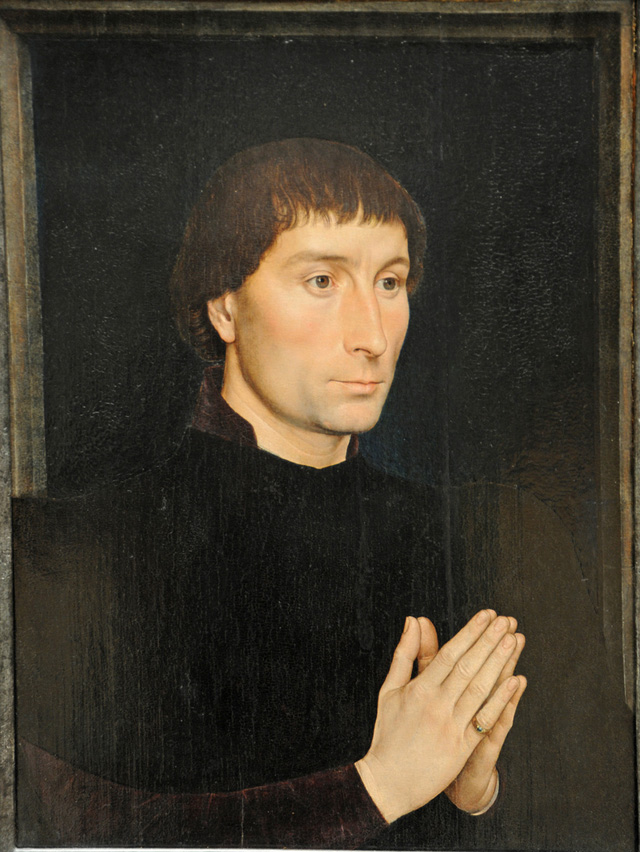HANS MEMLING
Seligenstadt, Alemania 1430 - Brujas 1494
Tommaso di Falco Portinari 1428 - 1501 (probablemente 1470)
Óleo sobre tabla. Dimensiones totales 44,1 x 33,7 cm
Superficie pintada 42,2 x 32,1 cm
Adquirido en 1913
Metropolitan Museum of Art, Nueva York Hans Memlig. Tommaso di Falco Portinari, probablemente 1470.
Las maderas actuales que sean de okume y que sean de barco, porque es un tipo de material muy bueno, que está muy bien secado, que rechaza el agua, no se alabea el cuadro, y cuando son unos formatos más grandes hacer un bastidor, esto si, para no tener sorpresas, porque la madera se mueve, ahora es muy difícil conseguir un bloque de madera de roble antiguo, curado, bien seco, y no secado por métodos artificiales, es un secado industrial, y no es un secado natural y quedan verdes algunas zonas, y claro se va secando solo esto, como puede, se fragmentan y se agrietan, y después se puede torcer. En la pintura hay unas intuiciones, una manera de resolver que dices, bueno, ¿cómo lo ha hecho? El color diluido en esa veladura de los maestros antiguos con pasajes de tonalidades delicadísimas, es el misterio del cuadro porque es algo inexplicable. Con esta técnica tan lenta y precisa, las imágenes se construyen desde el fondo. La ilusión de los drapeados entretejidos con hilos de oro se consigue con finas pinceladas de amarillo clarísimo sobre amarillo, alternadas con pequeños trazos ocre oscuro. Las tablas de las pinturas flamencas al óleo se preparan con una capa de creta blanca y cola animal. Resultan así compactas y lisas. En el óleo, los pigmentos mantienen el brillo sin modificar los tonos originales. La consistencia particular del óleo, unido a resinas duras, permite ejecutar detalles diminutos e imágenes lejanas, dándoles la misma importancia que a las de primer plano. El blanco de san Juan diluido en aceite produce el efecto luminoso casi perlado que se transmite en los rostros. Los pigmentos se han molido finamente en caliente con aceite y sé les ha añadido resinas como el ámbar. Hans Memling es el pintor de su época más destacado de Brujas. Estos retratos, obras maestras del arte renacentista septentrional, representan a Tommaso y Maria Portinari, miembros de la numerosa comunidad de mercaderes italianos en Brujas, ciudad en la que Tommaso dirigió la sucursal del banco Médicis de 1465 a 1478. Probablemente fueron encargados en 1470, en ocasión del casamiento de la pareja, cuando Maria tenía unos catorce años y Tommaso t reina y dos. Eran las alas de un tríptico portátil, flanqueando una imagen devocional de la Virgen y el Niño.
The woods that are current and are okoume boat , because it is a very good type of material , which is very well dried , it repels water , it warps the picture, and when they are about to make a larger format frame this if , to avoid surprises , because the wood is moved , it is now very difficult to get a block of old oak , cured , dry, and not by artificial drying is an industrial drying , and is not a natural drying and some areas remain green and dries clear only that, they can, are fragmented and split open, and then twisted. In the painting there are intuitions , one way to solve that say , well , how did it? The color diluted in the glaze of the old masters with very delicate shades passages , is the mystery of the box because it is inexplicable. With this technique as slowly and precisely , the images are built from the bottom . The illusion of draping interwoven with gold threads with fine brush is achieved quite clear yellow on yellow, alternating with small strokes umber . Tables Flemish oil paintings are made with a layer of white chalk and animal glue . They are so compact and smooth . In the oil painting , the pigments remain unchanged brightness tones oil originals. The particular consistency , coupled with hard resins , to run distant tiny details and images , giving the same importance to the foreground . John White of oil diluted the effect almost pearly light that is transmitted on the faces . The pigments are ground finely Be hot with oil and resins were added as ambar. Hans Memling is the painter of his time highlight of Bruges . These portraits , masterpieces of Northern Renaissance art , representing Tommaso and Maria Portinari , members of the large community of Italian merchants in Bruges , Tommaso city that led the Medici bank branch 1465-1478 . Probably were commissioned in 1470 , on the occasion of the marriage of the couple , when Mary was about fourteen and Tommaso? Queen and two . They were the wings of a triptych laptop, flanking a devotional image of the Virgin and Child.


No hay comentarios:
Publicar un comentario